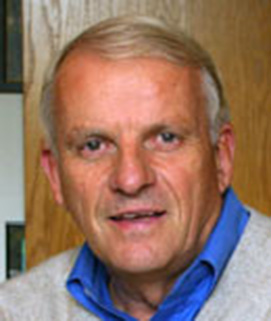
Föreläsning för Sydsvenska Medicinhistoriska Sällskapet 2018-09-06 i aulan, Universitetssjukhuset i Lund kl 18.
John Dowling, Harvard University, Cambridge / Boston, Mass., USA
John Dowling skriver följande om sin vetenskapliga verksamhet vid The Biological Laboratories vid Harvard University i Cambridge / Boston, Mass., USA.
The vertebrate retina is an accessible part of the central nervous system; an understanding of retinal mechanisms provides clues concerning neural mechanisms throughout the brain. Over the years, my group has been concerned with the cells of the retina - their structure, function, pharmacology, genetics, and synaptic interactions as well as their functional organization.
I am now a Research Professor and have closed my laboratory. However, I am presently working with Professor Jeff Lichtman and his colleagues, along with two collaborators at the University of Washington in Seattle, to reconstruct the fovea of the human retina. The fovea, a small indented retinal area on the visual axis of the eye, is responsible for all of our high acuity vision. Indeed, reading, recognizing faces, driving and watching television all depend on good foveal vision. If the fovea is damaged, as happens in Age-Related Macular Degeneration, a person loses these abilities, and is termed legally blind, the most common cause of legal-blindness in the western world. Using connectomic methods developed in the Lichtman laboratory, and human tissue obtained by our Seattle colleagues, we are cutting thousands of sections (4000 so far). We have imaged 1500 of them, resulting in the generation of 30,000 images that are being analyzed and reconstructed.
 |
| John E. Dowling |
John E. Dowling (f. 1935) var Gordon and Llura Gund Research Professor of Neurosciences vid Harvard University. Han har nyligen gått i pension och räknas som en av världens mest framstående näthinneforskare under andra halvan av 1900-talet. Han läste först medicin vid Harvard-universitetet, men drogs snart in i kretsen kring den blivande nobelpristagaren Georg Wald och började studera vad vitamin A gör för synen. George Wald fick Nobelpriset 1967 för sitt arbete om detta, och John Dowling följde först sin mentors linje. Det har varit känt sedan de egyptiska faraonernas och pyramidernas tid att det finns något i födans fett som människan behöver för god syn, särskilt i mörker. Vi kallar detta något för vitamin A, men den är bara en av flera varianter på en molekyl som spelar stor roll för vår hela vår utveckling och välbefinnande. Kunskapen om hur vitamin A och dess kemiska släktingar verkar har utvecklats på många intressanta sätt som professor Dowling kommer att berätta om.
Ett av de mest framträdande dragen i John Dowlings forskning har varit att han alltid har kombinerat anatomiska studier med bedömningar av cellers och vävnaders funktioner. I kombination med en anmärkningsvärd analytisk förmåga har han givit oss helt nya och oväntade insikter i hur näthinnan fungerar. Han driver inte längre ett eget laboratorium, men är aktiv som neurobiologisk forskare i samarbete med andra forskargrupper.